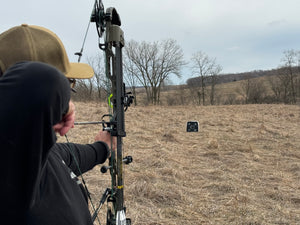Mastering the Fit: How to Determine Your Compound Bow Draw Length
Achieving accuracy and consistency in bowhunting hinges on a crucial factor – proper draw length. An improper draw length can lead to discomfort, fatigue, and ultimately, missed shots. Here, we delve into the different methods for determining your compound bow draw length, ensuring a perfect fit for optimal performance.
Understanding Draw Length:
Draw length refers to the distance between the grip of the bow and the nocking point (where the arrow rests on the string) when the bow is fully drawn. This distance should correspond to the full extension of your drawing arm, creating a comfortable and balanced anchor point (the point where your hand meets your face when drawing the bow - or "anchor point").
Measurement Methods:
There are two primary methods for determining your draw length:
1. The Wingspan Method (Estimated Draw Length):
- Stand tall with arms outstretched to your sides.
- Have someone measure the distance between the tips of your middle fingers.
- Divide this measurement by 2.5.
- This will provide you with an estimated draw length.
Important Note: The wingspan method is just an estimate, and individual variations exist. It's a good starting point, but further refinement might be necessary.
2. The Full Draw Method (Most Accurate):
- Seek assistance from an archery shop or experienced archer.
- Stand with good posture and relax your shoulders.
- The assistant will loosen the bow's draw weight (the pulling force required) for safety.
- Nock an arrow on the string (ensure a safe practice arrow).
- Raise the bow as if to shoot, keeping your arm straight.
- The assistant will slowly adjust the bow's draw length mechanism until your fingertips lightly touch the corner of your mouth or an anchor point you can consistently and comfortably reach.
- At this point, the bow should feel balanced and comfortable at full draw.
- Your draw length will then be the distance from the string to the brace point, or front of the arrow shelf.
Additional Tips:
- Don't force the draw. If you struggle to reach a comfortable anchor point, the draw length might be too long.
- Repeat the full draw method a few times to ensure consistency in the measurement.
- Many bow manufacturers offer online resources and printable draw length charts to assist you.
Beyond Measurement:
While measurement is crucial, how the bow feels at full draw is equally important. Here are some additional factors to consider:
- Pinch: Your bow grip should feel secure without forcing your anchor point.
- Stacking: Avoid "stacking" the bow, which refers to excessive pressure required to hold the bow at full draw. This indicates the draw length might be too short.
- Comfort: The overall feel of the draw cycle should be smooth and comfortable.
Fine-Tuning:
Most compound bows allow for slight adjustments to the draw length after initial measurement. Work with your archery shop to ensure your bow is set to your specific draw length.

